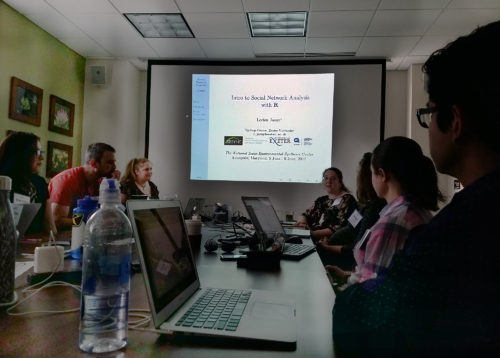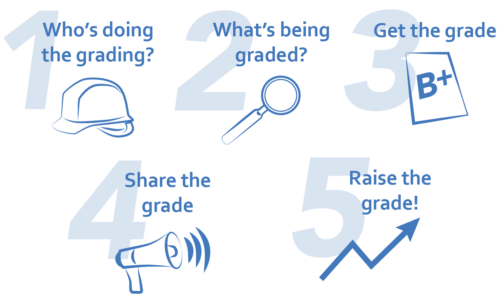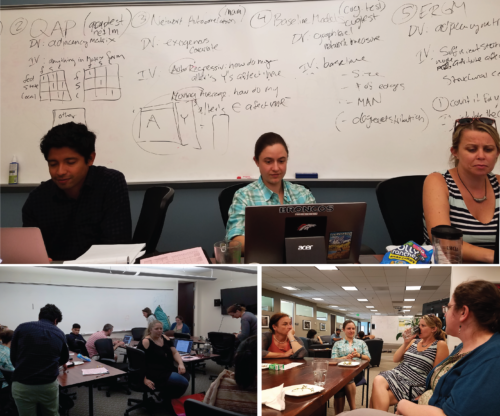Adding value to “Network” in IAN: Exploring the potential uses of Social Network Analysis
Vanessa Vargas-Nguyen ·Last June 5-9, 2017, I was fortunate enough to be selected to participate in SESYNC’s short course on Social Network Analysis (SNA) taught by Lorien Jasny, PhD, who was a postdoc at SESYNC but is now based at Exeter University in the UK. This introduction and crash course on Social Network Analysis was a great opportunity for me, as I will be using SNA in my dissertation research. I will be auditing a class on SNA taught by Dr. Christina Prell (one of my research committee members) this coming Fall semester, but in the meantime, I’ve only been studying on my own.

I first came across Social Network Analysis during my research on evolving IAN’s report card development process for more effective communication and engagement, with the eventual goal of influencing behavior change and collective action. In my comprehensive exams last October (2016), I advocated for the use of Systems Thinking to improve our report card development. I also proposed to expand our 5-step process to include careful stakeholder analysis, continuing evaluation/learning and capacity building. Stakeholder analysis in environmental resource management, as cited in Reed (2008), is a process that: (i) defines aspects of a social and natural system affected by a decision or action, (ii) identifies individuals and groups who are affected by or can affect those parts of the system (this may include non-human and non-living entities and future generations), and; (iii) prioritizes these individuals and groups for involvement in the decision-making process. This thinking has led to the revamping of IAN’s 5-step process to include stakeholder selection as the new first step (image below).

Originally, my cursory understanding of SNA was that it would be a great tool to identify key stakeholders and opinion leaders that could potentially make our report cards more robust. My thinking expanded when I was the Teaching Assistant for MEES 620 Coupled Earth and Natural Systems. Christina was one of the four professors teaching the class. Through her introduction of SNA, I had the idea to use SNA as a tool to help us evaluate the impacts of our report cards. Based on anecdotal evidence and our preliminary observations at IAN, the report card development process strengthens stakeholder ties (in most cases creates new ones) and improves communication among different stakeholder groups. With SNA, we could actually show how these connections formed and how our report card process changed the existing interaction among stakeholders.
During 5-day SESYNC SNA course, I learned of the different kinds of network relations that can be studied. A network in SNA is not just a metaphor: it is a precise, mathematical construct of nodes (vertices, actors) and edges (ties, relations) that can be directed or undirected. We can include information (attributes) on the nodes as well as the edges. Social Network Analysis is not only about interactions between people. Network relations can also be affective evaluation (who you trust, believe), resource transfer or flow (trade, information flow), movements, formal relationships (authority, leadership), joint participation or association, and other relationship that have logical implications. Actors in the network could be individuals, collectives or aggregates (organizations), and other units such as objects, locations, and beliefs. One of my favorite examples of applying networks is in this paper by Hoffman et al 2014 (image below) where they made a connection between a farmers' knowledge of sustainability and their adoption of sustainable farm practices.

The course also gave me new insights on how powerful social network analysis can be in our work at IAN. Lorien’s course was an excellent combination of introducing SNA concepts, applications and methods of analysis. The class was more R-programming intensive than I had anticipated but it was actually a pleasant surprise since it added another layer to my understanding of SNA – that aside from the qualitative aspects, social networks can be highly quantified, modeled and analyzed. In retrospect, this makes perfect sense since SNA is based on graph theory and matrix algebra. Again, it made me think of other potential uses of SNA in report cards. Increasingly, there is a demand to create more holistic report cards that can assess the interconnection between people and natural systems. This means incorporating ecological, socio-cultural, economic, health and governance indicators in one assessment. Not only can SNA potentially show the interconnection between all these indicators (each can be a network of its own), but certain characteristics of networks can also be used, in my opinion, as indicators that can be used in report cards. Potential indicators are network density and fragmentation, centrality measures and the type of network structure formed.
In our practice of science communication, we can also use SNA to design targeted communication strategies to have broader reach and behavior change impacts. We can use SNA to identify the flow of information in the system that we are working in, who the public turns to for information, and the different belief and value system that exists within the network, among others. We could also show if the network that we formed promotes environmental literacy and collaborative learning (which may eventually lead to behavior change and collective action).

The name "Integration and Application Network" emphasizes the focus of our group in scientific integration and application. The network component of IAN traditionally refers to the different agencies and institutions that comprise IAN and our distributed network of collaborating entities. Using Social Network Analysis, we can add value and depth to this “Network” component. The interaction and interconnection among the different networks of people (governance, experts, organizations, citizens, etc) and natural resources is very important. A deep understanding of all these will be key in overcoming collective action problems and in being able to solve environmental problems at different scales.
About the author
Vanessa Vargas-Nguyen

Dr. Vanessa Vargas-Nguyen is a Science Integrator with the Integration and Application Network and an associate faculty of the Marine Estuarine and Environmental Science Graduate Program. Her current interest is in transdisciplinary approaches, socio-environmental assessments, socio-environmental justice, stakeholder engagement, and adaptive environmental governance. Vanessa is originally from the Philippines and has extensive experience in molecular biology and marine science, specializing in microbial communities and molecular processes associated with Harmful Algal Blooms and shrimp, corals, and human diseases. She has since shifted her focus on how science can benefit society and was conferred with the first Ph.D. under the new Environment and Society foundation of the MEES graduate program. Her dissertation used ethnographic approaches to investigate the role of socio-environmental report cards in transdisciplinary collaboration and adaptive governance for a sustainable future. She received academic training from the University of the Philippines (BSc; MSc) and the University of Maryland (MSc; PhD). She is involved in developing holistic socio-environmental assessments for complex systems such as the Mississippi River and Chesapeake Bay watersheds and is coordinating a multi-year international transdisciplinary research consortium involving the US, Norway, Philippines, Japan, and India.
Next Post > WWF and UMCES Retreat 24-25 May 2017
Comments
-
George 9 years ago
"Social Network Analysis" seems to be a great topic for PhD dissertation. You have such a broad range to research upon under this topic. Thanks for sharing your research idea and methodology.